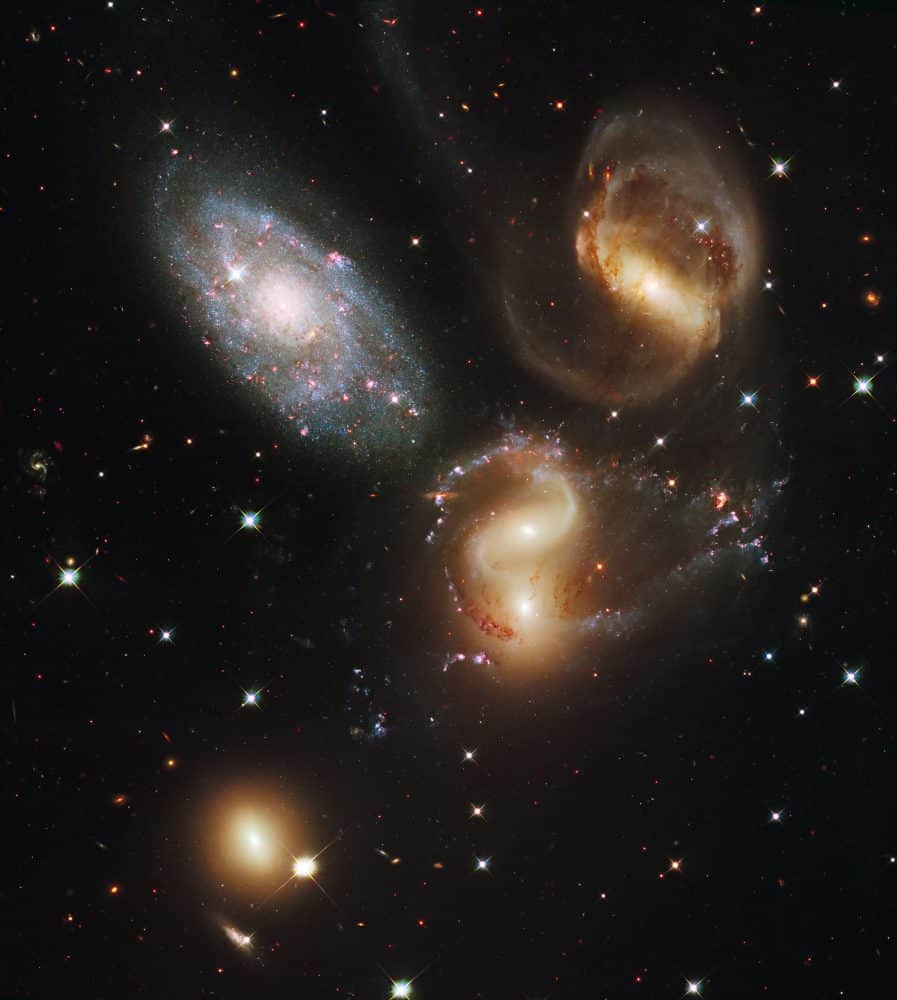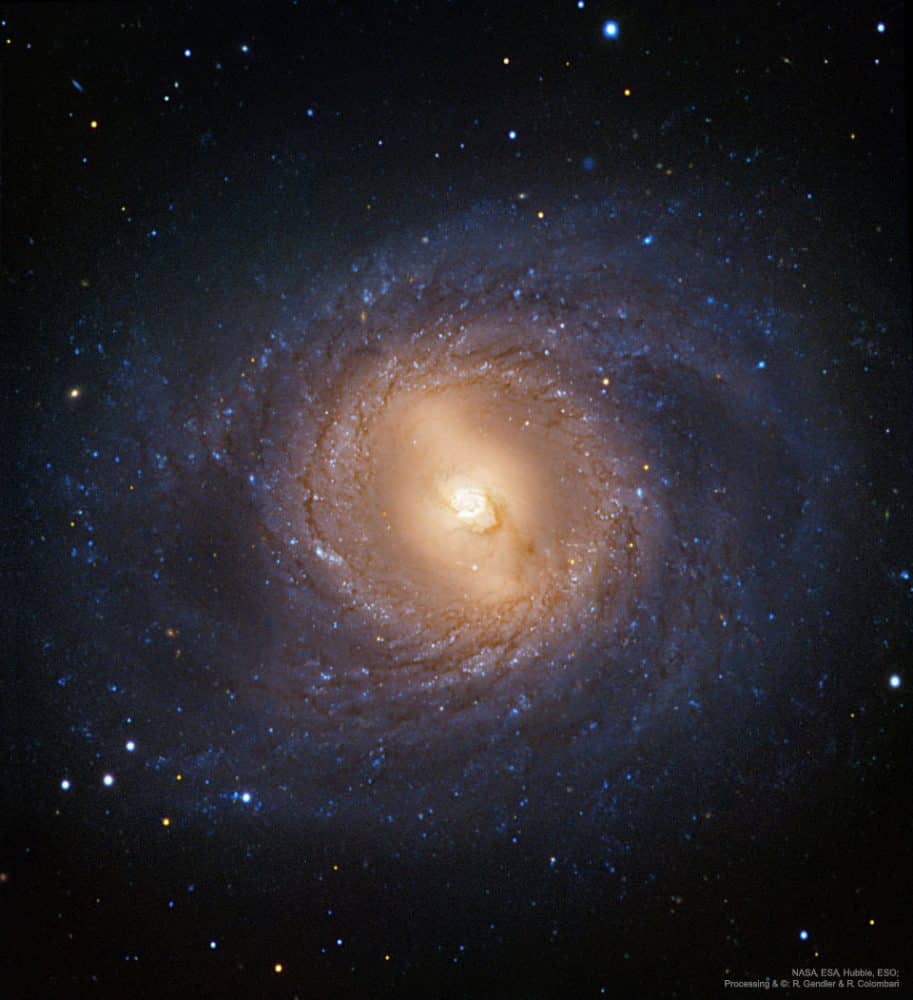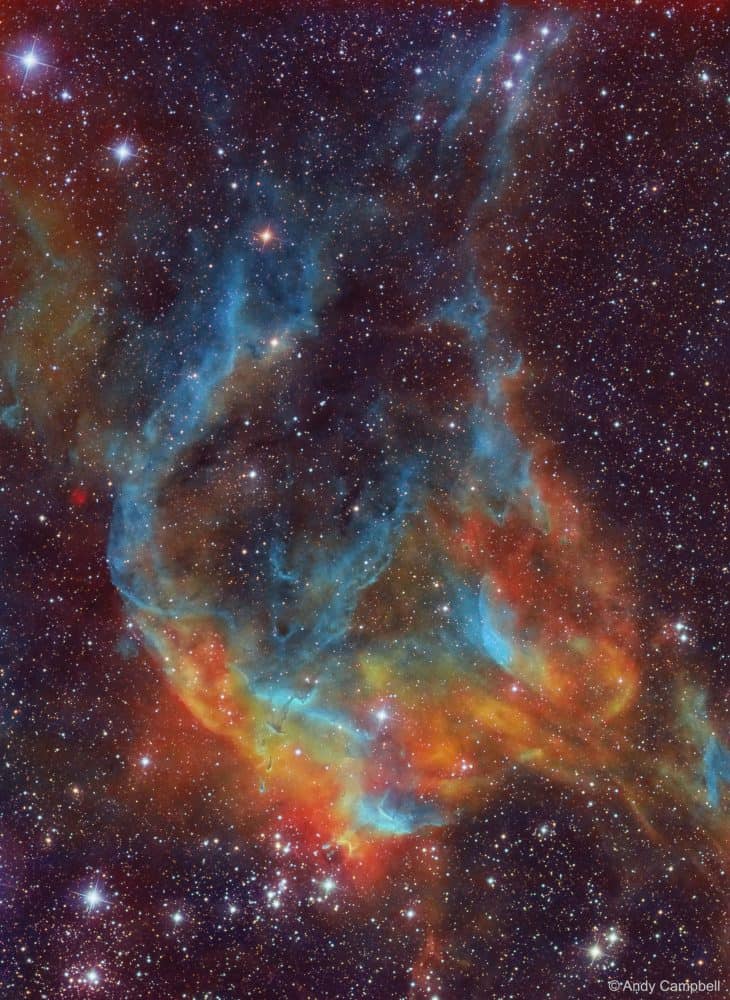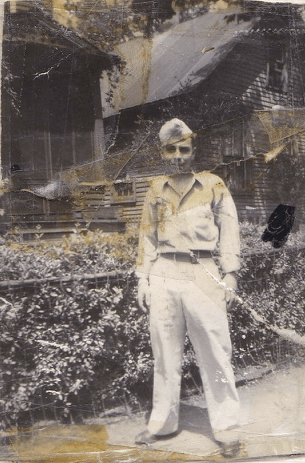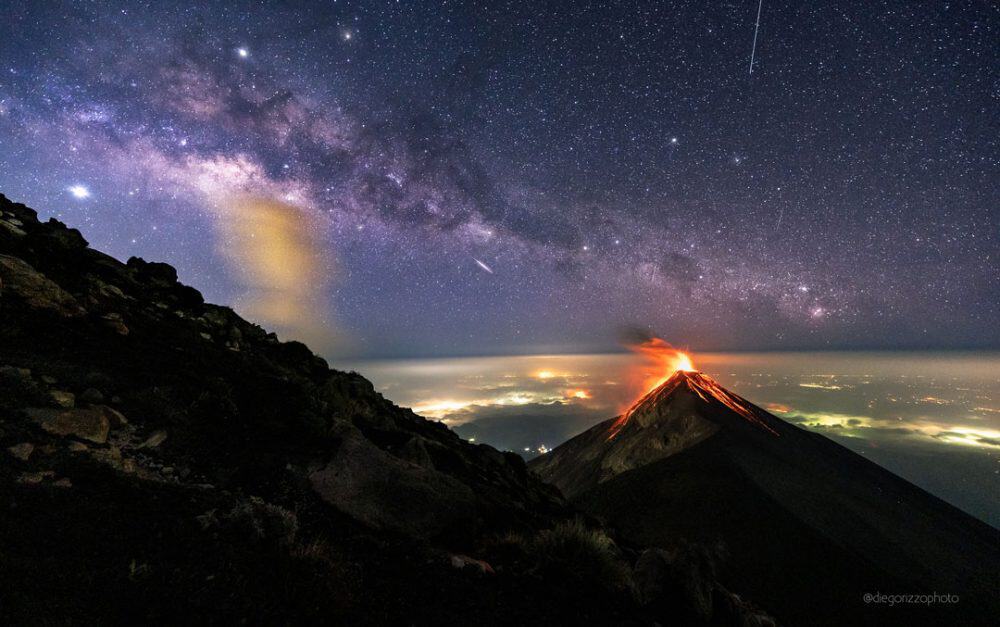Blog
Stephan’s Quintet is a visual grouping of five galaxies of which four form the first compact galaxy group ever discovered. The group, visible in the constellation Pegasus, was discovered by Édouard Stephan in 1877 at the Marseille Observatory. The group is the most studied of all the compact galaxy groups. The brightest member of the visual grouping is NGC 7320 that is shown to have extensive H II regions, identified as red blobs, where active star formation is occurring.
Four of the five galaxies in Stephan’s Quintet form a physical association, Hickson Compact Group 92, and will likely merge with each other. Radio observations in the early 1970s revealed a mysterious filament of emission which lies in inter-galactic space between the galaxies in the group. This same region is also detected in the faint glow of ionized atomic hydrogen seen in the visible part of the spectrum as a green arc.
Two space telescopes have recently provided new insight into the nature of the filament, which is now believed to be a giant intergalactic shock-wave (similar to a sonic boom but traveling in intergalactic gas rather than air) caused by one galaxy (NGC 7318B) falling into the center of the group at several millions of kilometers per hour.
more...5-30-62
Central to Darrell Grant’s music is a sense of purpose, agency, and connection to community.
Through eight albums as a bandleader, numerous recordings as a sideman, a growing body of compositions, and two decades of service as an educator and leader in the arts, Grant’s multi-faceted creative projects and innovative initiatives reflect a belief in the extraordinary power of art to communicate, inspire, provoke, inform, and move others to transform society and themselves.
“Darrell Grant is a musician worthy of some serious listening. He is a very fine pianist and composer.”
Speaking to Nat Hentoff for the liner notes to his debut CD Black Art, Grant told the renowned jazz critic that “the longer I play, the clearer it becomes that, at least for me, the goal is to give voice to the meanings behind the music. I have a deep desire to reach people, to communicate something of the things that I am finding to be true, with humor, with love, with silence, with swing, and with passion.” Telling those truths has been the driving force in Darrell Grant’s musical career.
DARRELL GRANT was introduced to international audiences in 1988 as the pianist with the legendary vocalist Betty Carter. He has performed and recorded with such notable musicians as Branford Marsalis, David Sanborn, Esperanza Spalding, John Clayton, Nicholas Payton, James Moody, Kevin Eubanks, Lenny White, Jane Bunnett, Somi, Tom Harrell, Jack Dejohnette, Terence Blanchard, and Art Farmer. He has performed extensively as a bandleader and solo artist throughout the U.S., Canada, and Europe in venues ranging from clubs to major jazz festivals, and been featured on Marian McPartland’s “Piano Jazz” on National Public Radio.
Born May 30, 1962 in Pittsburgh, Pennsylvania, Grant grew up in Denver, Colorado in a musical family. He began classical lessons at age seven and quickly received honors for his prowess on piano. He discovered jazz in school band programs and played family concerts and talent shows. At 15, he joined the Pearl Street Jazz Band, a precocious ensemble of teenaged musicians playing traditional New Orleans-style jazz. The group held down regular professional gigs, recorded two albums, and appeared at regional jazz festivals.
Harold Winston “Harry” Beckett (30 May 1935 – 22 July 2010) was a British trumpeter and flugelhorn player of Barbadian origin.
Born in Bridgetown, Saint Michael, Barbados, Harry Beckett learned to play music in a Salvation Army band. A resident in the UK since 1954, he had an international reputation. In 1961, he played with Charles Mingus in the film All Night Long. In the 1960s he worked and recorded within the band of bass player and composer Graham Collier. Beginning in 1970, he led groups of his own, recording for Philips, RCA and Ogun Recordsamong other labels.
He was a key figure of important groups in the British free jazz/improvised music scene, including Ian Carr‘s Nucleus, the Brotherhood of Breath and The Dedication Orchestra, London Jazz Composers Orchestra, London Improvisers Orchestra, John Surman‘s Octet, Django Bates, Ronnie Scott‘s Quintet, Kathy Stobart, Charlie Watts, Stan Tracey‘s Big Band and Octet; Elton Dean‘s Ninesense. He has also recorded with Keef Hartley, Jah Wobble, David Sylvian and worked with David Murray. He toured abroad with Johnny Dyani, Chris McGregor, Keith Tippett, John Tchicai, Joachim Kühn, Dudu Pukwana‘s Zila, George Gruntz‘s Bands, Belgian quintet The Wrong Object, Pierre Dørge‘s New Jungle Band and Annie Whitehead‘s Robert Wyatt project, Soupsongs, which also featured Phil Manzanera and Julie Tippetts, among other jazz and rock luminaries.
https://www.youtube.com/watch?v=xgio9T2K5LM
more...Armando Peraza (May 30, 1924 – April 14, 2014) was a Latin jazz percussionist and a member of the rock band Santana. Peraza played congas, bongos, and timbales. Born in Lawton Batista, Havana, Cuba in 1924 (although the birth year is uncertain),he was orphaned by age 7 and lived on the streets. When he was twelve, he supported himself by selling vegetables, coaching boxing, playing semi-pro baseball, and becoming a loan shark. His music career began at seventeen when he heard at a baseball game that bandleader Alberto Ruiz was looking for a conga player. Ruiz’s brother was on the same baseball team as Peraza. Despite the absence of experience in music, he practiced and won the audition.
In 1954, while in San Francisco with pianist Dave Brubeck, Peraza met Cal Tjader, Brubeck’s drummer at the time. Jazz critic Leonard Feather recommended Peraza to Fantasy Records with Tjader to record an Afro-Cuban album. The result was Ritmo Caliente, which combined Afro-Cuban rhythms with a jazz sensibility. He was introduced to British pianist George Shearing by bassist Al McKibbon. He spent the next twelve years with Shearing, a collaboration that put Peraza at the front of Afro-Cuban music. He emerged as a composer, writing and recording twenty-one songs for Shearing, such as “Mambo in Chimes”, “Mambo in Miami”, “Ritmo Africano”, “Armando’s Hideaway”, “This is Africa”, and “Estampa Cubana”. These recordings were during the mambo craze in the U.S. and the world. Peraza’s technique and power as a hand drummer became a feature of Shearing’s performances.
He toured all over the world with Shearing, but it was in America that he experienced persistent and institutionalized racism. In Miami during dates with Shearing and Peggy Lee in 1959, Peraza and black members of the band were prohibited from staying at the same hotel as the white musicians. Shearing and Lee resolved the situation by threatening to quit the performance unless Peraza and the others were allowed to stay at their hotel. Shearing’s was one of the first racially integrated jazz groups. While with Shearing, Peraza had opportunity to play with the classical symphonies of Boston, Philadelphia, New York, and Oklahoma City.
In 1959, Peraza joined Mongo Santamaría for the Mongo album with conga drummer Francisco Aguabella, another contemporary and friend of Peraza. “Afro-Blue” became a jazz standard after John Coltrane recorded it. The album combined with Yambo in the compilation Afro Roots in 1972.
First and foremost, M95 is one of the closer examples of a big and beautiful barred spiral galaxy. Visible in the featured combination of images from Hubble and several ground based telescopes are sprawling spiral arms delineated by open clusters of bright blue stars, lanes of dark dust, the diffuse glow of billions of faint stars, and a short bar across the galaxy center. What intrigues many astronomers, however, is the circumnuclear ring around the galaxy center visible just outside the central bar. Although the long term stability of this ring remains a topic of research, observations indicate its present brightness is at least enhanced by transient bursts of star formation. M95, also known as NGC 3351, spans about 50,000 light-years, lies about 30 million light years away, and can be seen with a small telescope toward the constellation of the Lion (Leo).
more...Daniel Robert Elfman (born May 29, 1953) is an American composer, singer, songwriter, and record producer. Elfman first became known for being the lead singer and songwriter for the band Oingo Boingo from 1974 to 1995. He is well known for scoring films and television shows, particularly his frequent collaborations with director Tim Burton. One of Elfman’s notable compositions is The Simpsons theme, which he wrote in 1989.
In 1976, Elfman entered the film industry as an actor. In 1980, he scored his first film, Forbidden Zone, directed by his older brother Richard Elfman. Among his honors are four Oscar nominations, a Grammy for Batman, an Emmy for Desperate Housewives, six Saturn Awards for Best Music, the 2002 Richard Kirk Award, and the Disney Legend Award.
Was born on May 29, 1953 in Los Angeles, California to a Jewish family from Poland and Russia.
more...Eugene Joseph Wright (born May 29, 1923), nicknamed The Senator, is an American jazz bassist, best known for his work as a member of The Dave Brubeck Quartet, in particular on the group’s most famous album, Time Out (1959), with pianist Brubeck, drummer Joe Morello and alto saxophonist Paul Desmond.
Wright had played with the Lonnie Simmons group, and led his own band, the Dukes of Swing, but his big break came when he was recruited by Dave Brubeck. He had a very solid, Kansas-city style, theoretically at odds with, but in practice an important component of, Brubeck’s cool, mannered jazz.
In addition to Brubeck, Wright has played with many jazz stars, including Count Basie, Charlie Parker, Billie Holiday, Carmen McRae, Buddy DeFranco, Cal Tjader, Kai Winding, Karen Hernandez, Sonny Stitt, Gene Ammons, Dottie Dodgion, Lee Shaw, Dorothy Donegan, and Monty Alexander.
Basically Wright is a book of his compositions for bass published by Hansen.
With the death of his bandleader Dave Brubeck on December 5, 2012, Wright is the only living member of the classic quartet.
more...Carl Story (May 29, 1916 – March 31, 1995) was an influential bluegrass musician and leader of his band the “Rambling Mountaineers”. He was dubbed “The Father of Bluegrass Gospel Music” by the governor of Oklahoma. Story was born in Lenoir, North Carolina into a musically inclined family. His father played the fiddle and his mother played the guitar and Story learned to master both fiddle, guitar and clawhammer banjo. In the early 1930s, after winning a fiddle contest, he joined “J. E. Clark and the Lonesome Mountaineers” performing at WLVA in Lynchburg, Virginia. In 1934, he formed the “Rambling Mountaineers” together with banjo player Johnny Whisnant and guitarists Dudley Watson and Ed McMahan. Within a year they played over radio station WHKY in Hickory, North Carolina. It later led to performances at WSPA in Spartanburg, South Carolina and WWNC in Asheville, North Carolina. They recorded for ARC in 1939 and Okeh Records in 1940; however, these recordings were never issued. Story played with Bill Monroe in 1942 as a fiddler – replacing Howdy Forrester who had been drafted – but eventually he was drafted too in October 1943.
After his discharge from the Navy in 1945, he began performing with his “Rambling Mountaineers” on the “Mid-Day Merry-Go-Round” show at WNOX in Knoxville, Tennessee. In 1947, he recorded for the Mercury label. At the recording sessions of 1947, Story temporarily labelled his band the “Melody Four Quartet”. During the 1950s, Carl Story’s “Rambling Mountaineers” performed on the “Farm and Fun Time Show” at WCYB in Bristol, Virginia and on the “Cas Walker Show” over WBIR-TV in Knoxville, Tennessee. His “Mountaineers” also appeared on radio stations WAYS in Charlotte, North Carolina, WEAS in Decatur, Georgia, and WLOS in Asheville, North Carolina. He had a new recording contract on Columbia Records in 1953. Two years later he was back to Mercury Records. In 1957, he switched label to Starday Records where he stayed for eighteen years. In 1960, Story began working as a deejay for WFLW in Monticello, Kentucky. Beginning in the 1960s, and for the next twenty years, Story toured extensively throughout the USA and Europe. He signed another recording contract with CMH Records in the mid-1970s. He settled down in Greer, South Carolina working as a deejay over WCKI in Greer.
more...This chromatic cosmic portrait features glowing gas and dark dust near some recently formed stars of NGC 3572, a little-studied star cluster near the Carina Nebula. Stars from NGC 3572 are visible near the bottom of the image, while the expansive gas cloud above is likely what remains of their formation nebula. The image‘s striking hues were created by featuring specific colors emitted by hydrogen, oxygen, and sulfur, and blending them with images recorded through broadband filters in red, green, and blue. This nebula near NGC 3572 spans about 100 light years and lies about 9,000 light years away toward the southern constellation of the Ship’s Keel (Carina). Within a few million years the pictured gas will likely disperse, while gravitational encounters will likely disperse the cluster stars over about a billion years.
more...Leland Bruce Sklar (born May 28, 1947) is an American electric bass guitarist and session musician. He is a member of the Los Angeles-based instrumental group The Section, who served as the de facto house band of Asylum Records and were one of the progenitors of the soft rock sound prevalent on top-40 radio in the 1970s and 1980s. Besides appearing as the backing band on numerous recordings by artists such as Jackson Browne, Carole King, and James Taylor, the Section also released three solo albums of instrumental rock. Both in The Section and separately, Sklar has contributed to over 2,000 albums as a session musician. He also has toured extensively with major rock and pop acts, and recorded many soundtracks to films and television shows.
Sklar studied at California State University, Northridge. It was during that time he met James Taylor, who invited him to play bass at some venues. They both thought that the work would be short-term, but soon Taylor’s career took off with his first hit records, and Sklar came into the limelight. He was soon asked to record with others, and his long career began. In the 1970s, Sklar worked so frequently with drummer Russ Kunkel, guitaristDanny Kortchmar, and keyboardist Craig Doerge that they eventually became known as “The Section” and recorded three albums under that name between 1972 and 1977.
more...
Aaron Thibeaux “T-Bone” Walker (May 28, 1910 – March 16, 1975) was an American blues guitarist, singer, songwriter and multi-instrumentalist, who was a pioneer and innovator of the jump blues and electric bluessound. In 2018 Rolling Stone magazine ranked him number 37 on its list of “The 100 Greatest Guitarists of All Time”. Walker was born in Linden, Texas, of African-American and Cherokee descent. His parents, Movelia Jimerson and Rance Walker, were both musicians. His stepfather, Marco Washington, taught him to play the guitar, ukulele, banjo, violin, mandolin, and piano.
In 1942, Charlie Glenn, the owner of the Rhumboogie Café, brought T-Bone Walker to Chicago for long-time stints in his club. In 1944 and 1945, Walker recorded for the Rhumboogie label, which was tied to the club, backed up by Marl Young‘s orchestra.
T-Bone Walker performed at the second famed Cavalcade of Jazz concert held at Wrigley Field in Los Angeles produced by Leon Hefflin Sr. on October 12, 1946. Jack McVea, Slim Gaillard, The Honeydrippers, Lionel Hampton and his Orchestra, and Louis Armstrong were all on the same program. He also performed for the third Cavalcade of Jazz concert held in the same location on September 7, 1947 along with Woody Herman as Emcee, The Valdez Orchestra, The Blenders, The Honeydrippers, Slim Gaillard, Johnny Otis and his Orchestra, Toni Harper, The 3 Blazers and Sarah Vaughn.
Much of his output was recorded from 1946 to 1948 for Black & White Records, including his most famous song, “Call It Stormy Monday (But Tuesday Is Just as Bad)” (1947). Other notable songs he recorded during this period were “Bobby Sox Blues” (a number 3 R&B hit in 1947) and “West Side Baby” (number 8 on the R&B singles chart in 1948).
Andrew Dewey Kirk (May 28, 1898 – December 11, 1992) was a jazz saxophonist and tubist who led the Twelve Clouds of Joy, a band popular during the swing era.
Kirk grew up in Denver, Colorado, where he was tutored by Wilberforce Whiteman, Paul Whiteman’s father.Kirk started his musical career playing with George Morrison’s band, but then went on to join Terrence Holder‘s Dark Clouds of Joy. In 1929 he was elected leader after Holder departed. Renaming the band Clouds of Joy, Kirk also relocated the band from Dallas, Texas, to Kansas City, Missouri. Although named the Clouds of Joy, the band has also been known as the Twelve Clouds of Joy due to the number of musicians in the band. They set up in the Pla-Mor Ballroom on the junction of 32nd and Main in Kansas City and made their first recording for Brunswick Records that same year. Mary Lou Williams came in as pianist at the last moment, but she impressed Brunswick’s Dave Kapp, so she became a member of the band.
Kirk moved the band to Kansas City, and since their first recordings in 1929–1930, they grew popular as they epitomized the Kansas City jazz sound. In mid-1936, he was signed to Decca and made scores of popular records until 1946.
https://www.youtube.com/watch?v=lF_o8O4ANL4
more...https://www.youtube.com/watch?v=ZXLEBzdpdF0
more...https://www.youtube.com/watch?v=KQPyk4OUkeA&list=PLEB3LPVcGcWZ0hsQ5_jgSMhawAnDzy1io&index=2&t=0s
more...My dad Mike LaBriola as a teenager and soldier during WWII. He was stationed in Italy his place of birth. Now fighting the Nazi/Mussolini occupation as an American soldier. Pictured here in Blue Island, Ill
more...Volcan de Fuego is an active stratovolcano in Guatemala, on the borders of Chimaltenango, Escuintla and Sacatepéquez departments. It sits about 16 kilometres (9.9 mi) west of Antigua, On the land of the featured image, for example, the Volcano of Fire (Volcán de Fuego) is seen erupting topped by red-hot, wind-blown ash and with streams of glowing lava running down its side. Lights from neighboring towns are seen through a thin haze below. In the sky, though, the central plane of our Milky Way Galaxy runs diagonally from the upper left, with a fleeting meteor just below, and the trail of a satellite to the upper right. The planet Jupiter also appears toward the upper left, with the bright star Antares just to its right. Much of the land and the sky were captured together in a single, well-timed, 25-second exposure taken in mid-April from the side of Fuego‘s sister volcano Acatenango in Guatemala. The image of the meteor, though, was captured in a similar frame taken about 30 minutes earlier — when the volanic eruption was not as photogenic — and added later digitally.
more...More Posts
- World Music with Anda Union
- Daily Roots with Forest Man
- The Cosmos with NGC 3372
- Robin Ford Day
- John Abercrombie Day
- Johnny Hammond Smith Day
- World Music with the Pink Martini Orchestra
- Daily Roots with the Meditations
- The Cosmos with M78
- Eddie Palmieri Day
- Dannie Richmond Day
- Cutis Fuller Day
- World Music with Magzoub Unssa
- Daily Roots with Chokey Taylor
- Bob Bielefeld Memorial
- The Cosmos with NGC 1559
- Cecil Payne Day
- Clark Terry Day
- World Music with Moraito Chico, el Zambo, J Mendez, Peña Tio J de Paula y Tomatito
- Daily Roots with Jimmy Riley
